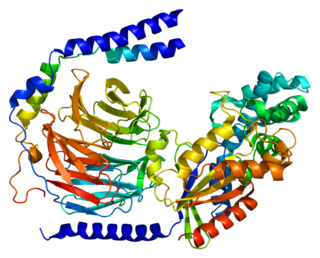
The S100 proteins are a family of low molecular-weight proteins found in vertebrates characterized by two calcium-binding sites that have helix-loop-helix ("EF-hand-type") conformation. At least 21 different S100 proteins are known. They are encoded by a family of genes whose symbols use the S100 prefix, for example, S100A1, S100A2, S100A3. They are also considered as damage-associated molecular pattern molecules (DAMPs), and knockdown of aryl hydrocarbon receptor downregulates the expression of S100 proteins in THP-1 cells.

S100 calcium-binding protein A7 (S100A7), also known as psoriasin, is a protein that in humans is encoded by the S100A7 gene.

S100 calcium-binding protein A2 (S100A2) is a protein that in humans is encoded by the S100A2 gene and it is located on chromosome 1q21 with other S100 proteins.

Retinoic acid receptor beta (RAR-beta), also known as NR1B2 is a nuclear receptor that in humans is encoded by the RARB gene.

G-protein coupled receptor 31 also known as 12-(S)-HETE receptor is a protein that in humans is encoded by the GPR31 gene. The human gene is located on chromosome 6q27 and encodes a G-protein coupled receptor protein composed of 319 amino acids.

Retinoic acid-induced protein 3 is a protein that in humans is encoded by the GPRC5A gene. This gene and its encoded mRNA was first identified as a phorbol ester-induced gene, and named Phorbol Ester Induced Gen 1 (PEIG1); two years later it was rediscovered as a retinoic acid-inducible gene, and named Retinoic Acid-Inducible Gene 1 (RAIG1). Its encoded protein was later named Retinoic acid-induced protein 3.

S100 calcium-binding protein A9 (S100A9) also known as migration inhibitory factor-related protein 14 (MRP14) or calgranulin B is a protein that in humans is encoded by the S100A9 gene.

S100 calcium-binding protein A6 (S100A6) is a protein that in humans is encoded by the S100A6 gene.

S100 calcium-binding protein A11 (S100A11) is a protein that in humans is encoded by the S100A11 gene.

Guanine nucleotide-binding protein G(I)/G(S)/G(O) subunit gamma-2 is a protein that in humans is encoded by the GNG2 gene.

Retinol binding protein 1, cellular, also known as RBP1, is a protein that in humans is encoded by the RBP1 gene.

S100 calcium-binding protein P (S100P) is a protein that in humans is encoded by the S100P gene.

Calpain small subunit 1, also known as CAPN4, is a protein that in humans is encoded by the CAPNS1 gene.

S100 calcium-binding protein A13 (S100A13) is a protein that in humans is encoded by the S100A13 gene.

Band 4.1-like protein 1 is a protein that in humans is encoded by the EPB41L1 gene.

Cellular retinoic acid-binding protein 1 is a protein that in humans is encoded by the CRABP1 gene.

Inositol 1,4,5-trisphosphate receptor, type 3, also known as ITPR3, is a protein which in humans is encoded by the ITPR3 gene. The protein encoded by this gene is both a receptor for inositol triphosphate and a calcium channel.

Ryanodine receptor 3 is one of a class of ryanodine receptors and a protein that in humans is encoded by the RYR3 gene. The protein encoded by this gene is both a calcium channel and a receptor for the plant alkaloid ryanodine. RYR3 and RYR1 control the resting calcium ion concentration in skeletal muscle.

S100 calcium-binding protein A15 (S100A15), also known as koebnerisin and S100 calcium-binding protein A7A (S100A7A), is a protein that in humans is encoded by the S100A7A (alias:S100A15) gene.
The S100 calcium-binding protein mS100a7a15 is the murine ortholog of human S100A7 (Psoriasin) and human S100A15 (Koebnerisin). mS100a7a15 is also known as S100a15, mS100a7 and mS100a7a and is encoded by the mS100a7a gene





















